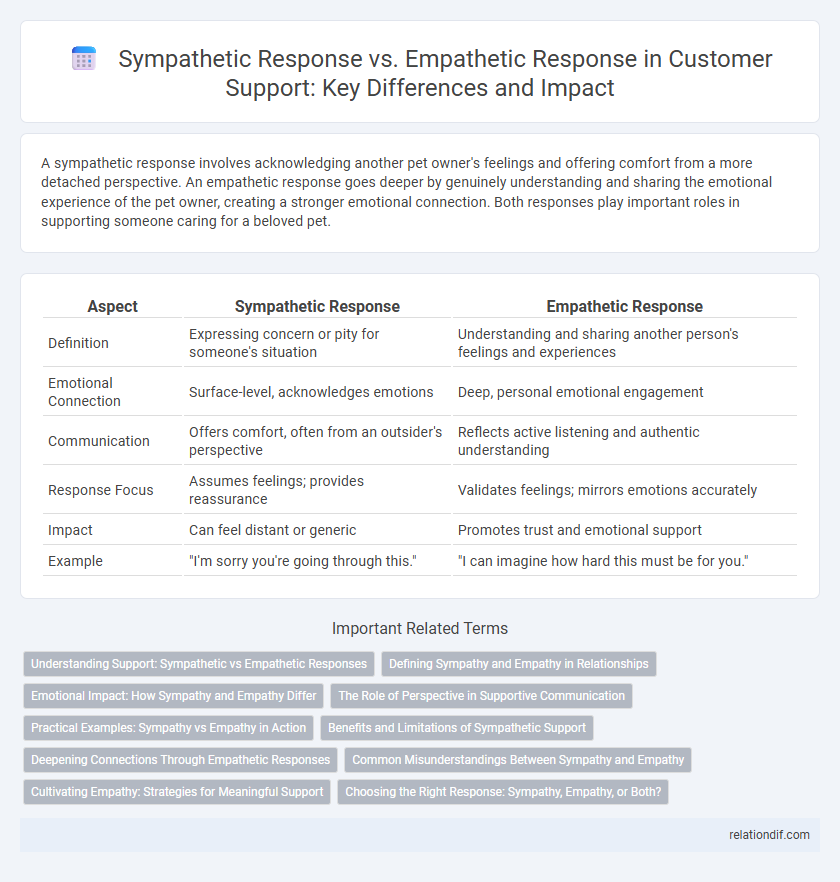A sympathetic response involves acknowledging another pet owner's feelings and offering comfort from a more detached perspective. An empathetic response goes deeper by genuinely understanding and sharing the emotional experience of the pet owner, creating a stronger emotional connection. Both responses play important roles in supporting someone caring for a beloved pet.
Table of Comparison
| Aspect | Sympathetic Response | Empathetic Response |
|---|---|---|
| Definition | Expressing concern or pity for someone's situation | Understanding and sharing another person's feelings and experiences |
| Emotional Connection | Surface-level, acknowledges emotions | Deep, personal emotional engagement |
| Communication | Offers comfort, often from an outsider's perspective | Reflects active listening and authentic understanding |
| Response Focus | Assumes feelings; provides reassurance | Validates feelings; mirrors emotions accurately |
| Impact | Can feel distant or generic | Promotes trust and emotional support |
| Example | "I'm sorry you're going through this." | "I can imagine how hard this must be for you." |
Understanding Support: Sympathetic vs Empathetic Responses
Sympathetic responses involve acknowledging someone's feelings and offering comfort from an observer's perspective, often expressed through phrases like "I'm sorry you're going through this." Empathetic responses require deeper emotional engagement, where the supporter actively listens and shares in the person's experience, fostering a sense of connection and validation. Understanding this distinction enhances effective support by tailoring communication to meet emotional needs accurately and compassionately.
Defining Sympathy and Empathy in Relationships
Sympathy in relationships involves recognizing another person's emotional hardship and expressing concern or sorrow, often maintaining an emotional distance. Empathy goes deeper by actively understanding and sharing the feelings of others, fostering stronger emotional connections and trust. Effective support hinges on balancing sympathy's acknowledgment with empathy's immersive perspective-taking to enhance relational understanding and care.
Emotional Impact: How Sympathy and Empathy Differ
Sympathetic response often involves feeling concern or sorrow for someone's situation, creating emotional distance while acknowledging their pain. Empathetic response engages deeper by sharing and understanding the person's emotional experience, fostering a stronger emotional connection. This difference impacts support effectiveness, as empathy promotes healing through validation and shared feelings, whereas sympathy tends to provide comfort without fully immersing in the emotional state.
The Role of Perspective in Supportive Communication
Sympathetic response involves acknowledging another person's feelings from an external viewpoint, often expressing concern or pity without fully understanding their emotional experience. Empathetic response requires immersing oneself in the other person's perspective to genuinely comprehend and share their emotions, fostering deeper connection and trust. This role of perspective in supportive communication enhances emotional validation and encourages more effective, compassionate interactions.
Practical Examples: Sympathy vs Empathy in Action
Sympathetic responses often involve expressing sorrow for someone's situation, such as saying, "I'm sorry for your loss," which acknowledges their pain without sharing it. Empathetic responses go deeper, like listening actively and saying, "I can imagine how hard this must be for you," demonstrating a genuine attempt to understand and feel the other person's emotions. In support scenarios, empathy fosters stronger connections and trust by validating experiences, while sympathy may keep interactions more distant and surface-level.
Benefits and Limitations of Sympathetic Support
Sympathetic support provides immediate emotional relief by acknowledging another's feelings, fostering a sense of being heard and cared for. It can be beneficial in urgent situations requiring quick reassurance but may risk oversimplifying complex emotions and creating emotional distance. Limitations include potential lack of deep understanding and reduced effectiveness in promoting long-term emotional healing compared to empathetic responses.
Deepening Connections Through Empathetic Responses
Empathetic responses deepen connections by actively acknowledging and validating another person's emotions, creating a genuine sense of understanding and trust. Unlike sympathetic responses that express pity or sorrow, empathy involves putting oneself in the other's shoes, fostering intimacy and meaningful dialogue. Prioritizing empathetic communication enhances emotional support and strengthens interpersonal relationships effectively.
Common Misunderstandings Between Sympathy and Empathy
Sympathetic responses often involve expressing pity or sorrow for someone's situation, which can sometimes create emotional distance rather than connection. Empathetic responses require truly understanding and sharing another person's feelings, fostering deeper emotional support and validation. Common misunderstandings arise when sympathy is mistaken for empathy, leading to well-meaning but less effective support interactions.
Cultivating Empathy: Strategies for Meaningful Support
Cultivating empathy involves actively listening to others' experiences and validating their feelings to provide meaningful support. Implement practices like perspective-taking exercises and reflective communication to deepen understanding beyond surface-level sympathy. Empathetic responses foster genuine connection by prioritizing emotional resonance and personalized support strategies.
Choosing the Right Response: Sympathy, Empathy, or Both?
Choosing the right response between sympathy and empathy depends on the context and the needs of the person seeking support. Sympathy expresses understanding and concern from a distance, often offering comfort without fully engaging in the other's emotions, while empathy involves deeply connecting with and sharing the feelings of another, fostering stronger emotional support and trust. Combining both can provide compassionate care by acknowledging emotions and actively validating the individual's experience.
Sympathetic response vs Empathetic response Infographic

 relationdif.com
relationdif.com